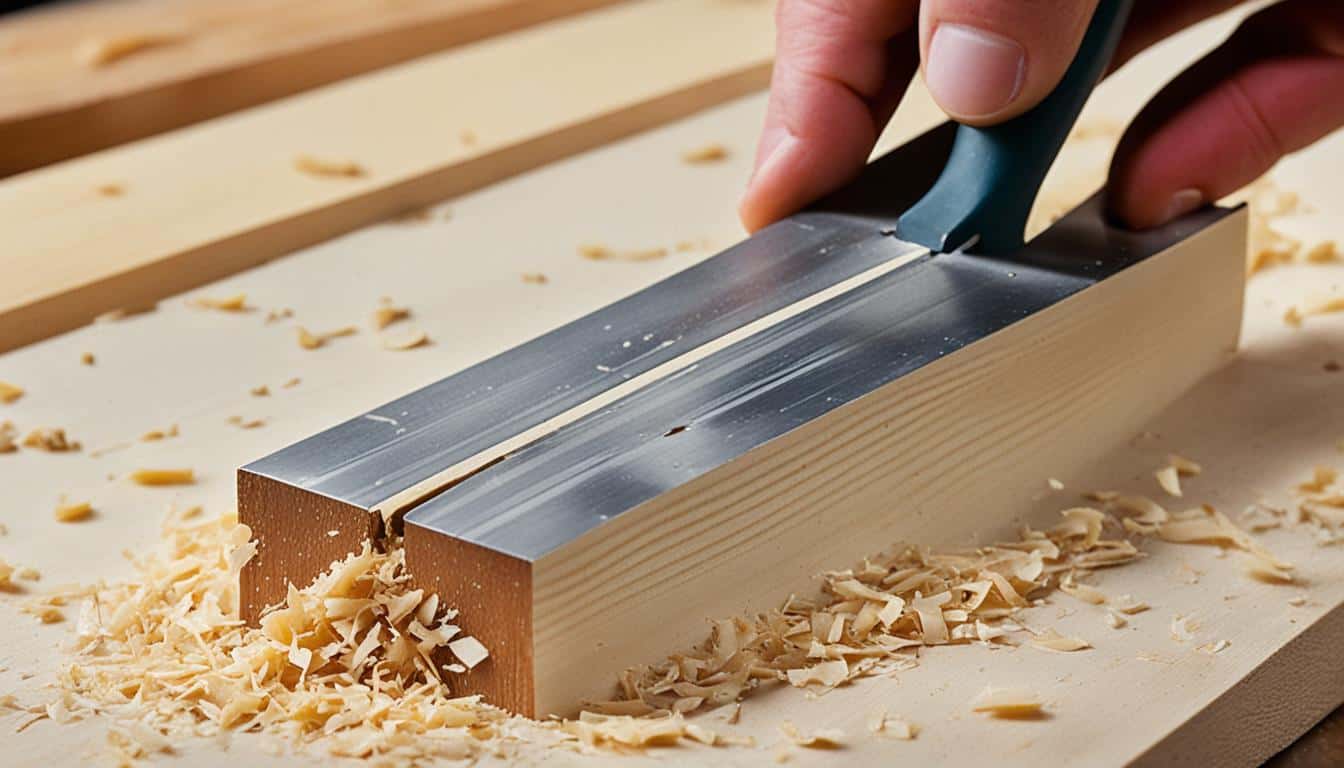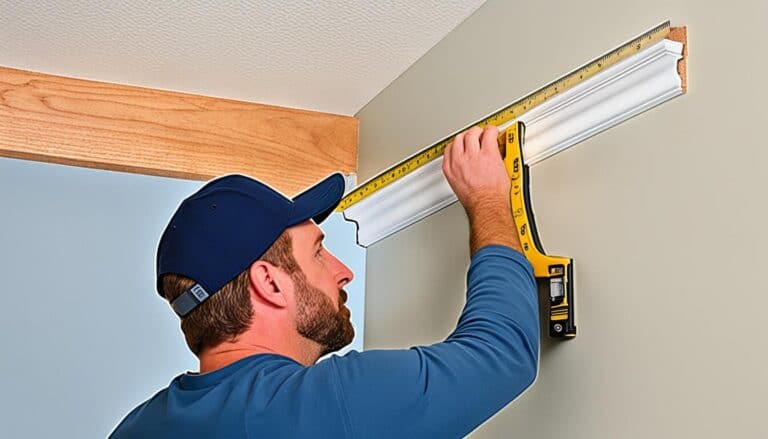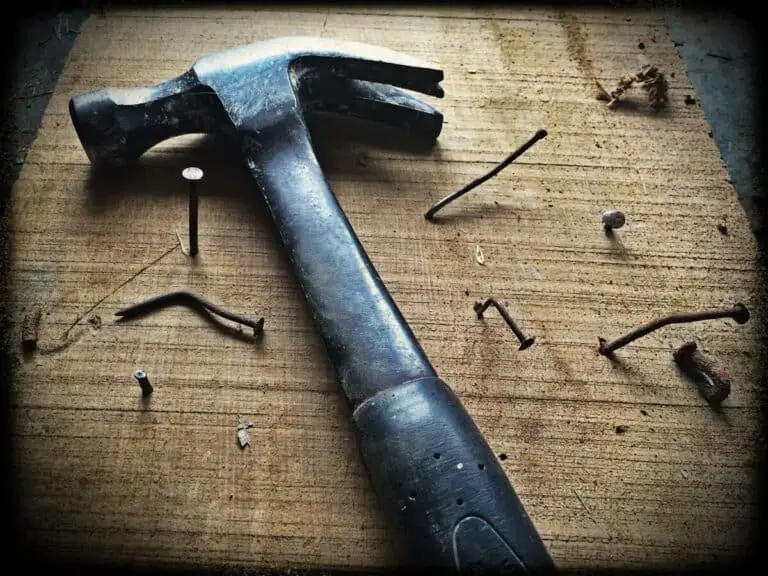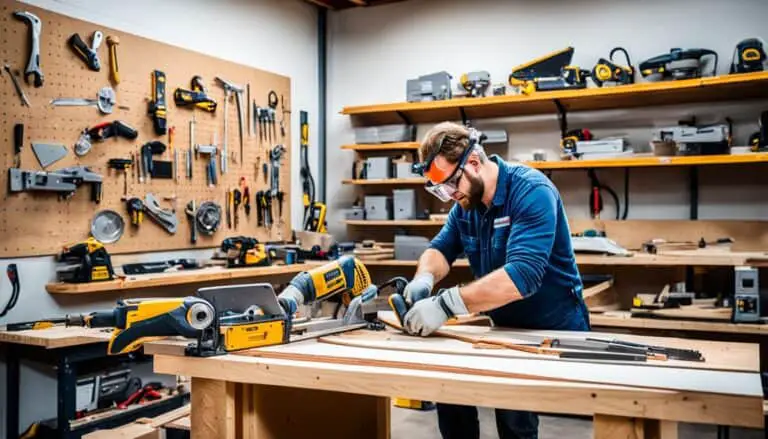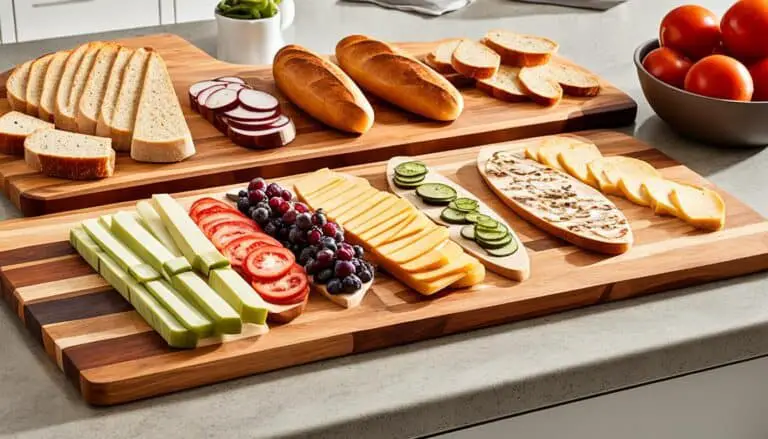If you’re a woodworking professional looking to enhance your skills and achieve a flawless finish in your projects, mastering the art of using hand planes is essential. Hand planes are versatile woodworking tools used for shaping, smoothing, and refining wood surfaces. In this article, we’ll explore different types of hand planes, including smoother planes and block planes, and discuss various hand plane techniques that will take your woodworking to the next level.
Key Takeaways:
- Hand planes are valuable hand tools for woodworking professionals.
- They can be used for shaping, smoothing, and refining wood surfaces.
- There are different types of hand planes, such as smoother planes and block planes.
- Mastering hand plane techniques is crucial for achieving a flawless finish in woodworking projects.
- Investing in high-quality hand planes and learning proper maintenance is important for optimal performance.
The Versatility of Hand Planes in Furniture Making
Hand planes are not just cleanup tools in furniture making; they can also play a crucial role in stock preparation, fine-tuning components, and trimming glued-up assemblies. By incorporating hand planes into your woodworking process, you can achieve a polished surface unmatched by machines or sandpaper. Hand planes excel at removing mill marks, taming panel glue-ups, fine-tuning frames, fitting doors, and cleaning up dovetails.
When it comes to furniture making, hand planes offer a level of precision and control that other tools simply cannot match. They allow you to shape and refine your work, ensuring every detail meets your exacting standards. Whether you’re preparing rough-cut stock for joinery or fine-tuning components for a perfect fit, hand planes are indispensable.
One of the primary applications of hand planes in furniture making is stock preparation. Before you can start building your masterpiece, you need to ensure your stock is straight, flat, and square. Hand planes are perfect for this task, allowing you to remove any imperfections and produce the ideal starting point for your project.
Hand planes are also useful for fine-tuning components. Whether it’s creating a smooth surface on a tabletop or fitting a drawer perfectly into its housing, hand planes give you the ability to make precise adjustments and ensure everything fits together seamlessly.
Additionally, hand planes can be invaluable for trimmings glued-up assemblies. When working with multiple pieces that have been joined together, there are often slight variations in height and alignment. A well-tuned hand plane can easily level out these inconsistencies, making your glued-up assembly appear as if it was made from a single piece of wood.
Incorporating hand planes into your furniture making process allows you to add a personal touch to your work. Each stroke of the plane is a deliberate action, shaping and refining the wood according to your vision. The control and satisfaction that come from using a hand plane are unparalleled, elevating your craftsmanship to new heights.
Hand planes not only refine the wood, but they also refine the woodworker—instilling patience, precision, and a deeper understanding of the material they work with.
With their versatility and precision, hand planes are indispensable tools for every furniture maker. Whether you’re a seasoned professional or just starting your woodworking journey, incorporating hand planes into your process will elevate your projects to the next level.
Incorporating Hand Planes in Basic Stock Preparation
When it comes to basic stock preparation, hand planes are invaluable tools in the woodworking arsenal. These versatile tools, such as the bench plane, jack plane, and smoother plane, play a crucial role in achieving optimal surface quality for your woodworking projects. Whether you’re working on faces, edges, or ends of wood, hand planes can help you get rid of ripples and ridges left by machines, ensuring a smooth and polished finish.
The jack plane, also known as the bench plane, shines when it comes to heavy mill marks. Its robust construction and effective blade design make it the go-to tool for removing deep and stubborn imperfections on wood surfaces. And once the heavy mill marks are addressed, it’s time to bring in the smoother plane.
The smoother plane is specifically designed to clean up any remaining marks left on the wood surface by the jack plane. Its fine-tuned setup and narrower throat allow for a more controlled and precise removal of imperfections, resulting in a flawlessly smooth and polished surface ready for further woodworking processes.
Maximizing the Potential of Hand Planes in Stock Preparation
Here are some tips to help you incorporate hand planes effectively in your stock preparation process:
- Start with a rough board: Hand planes excel at leveling rough boards and removing irregularities, allowing you to work with a more consistent and even surface.
- Use proper technique: Hold the hand plane with a firm grip, applying even pressure and maintaining a consistent angle as you glide the plane across the wood surface. This technique ensures an even removal of material and prevents gouges or uneven marks.
- Work diagonally or across the grain: By working at cross-grain angles, hand planes can effectively flatten and level the wood surface, removing any high spots or imperfections.
- Adjust the blade depth: Experiment with different blade depths to find the optimal setting for your desired surface finish. Gradually increase the blade depth until you achieve the desired result.
Incorporating hand planes into your stock preparation process not only improves surface quality but also allows for a more hands-on and intimate woodworking experience. Embrace the versatility of these timeless tools and experience the satisfaction of creating beautifully smooth wood surfaces.
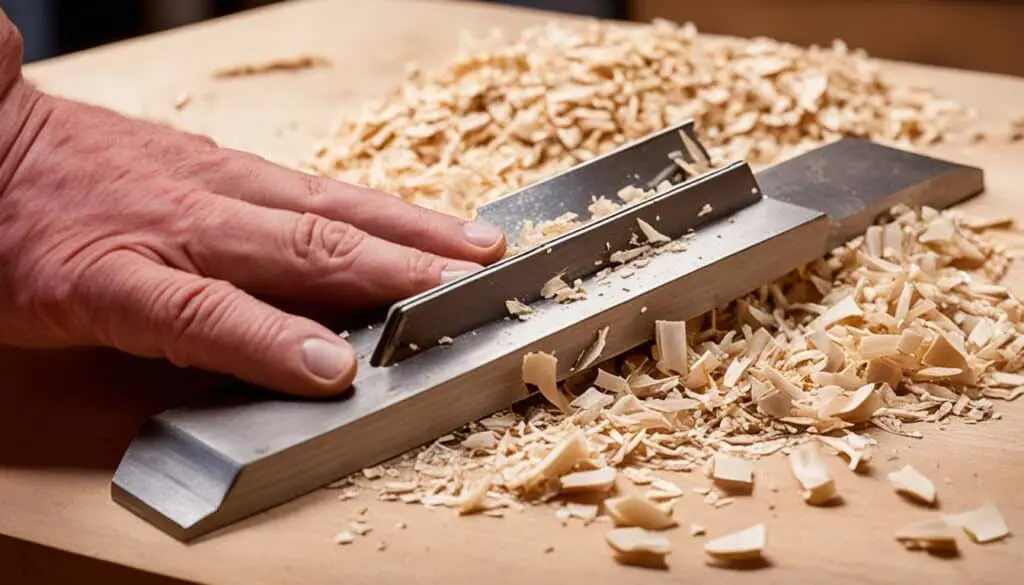
Choosing the Right Hand Planes for Beginners on a Budget
As a beginner woodworker working with a small budget, it’s crucial to invest in the right hand planes. These tools will be your trusted companions in your woodworking journey, allowing you to create smooth and precise finishes. While high-quality hand planes can sometimes be expensive, there are affordable options that won’t break the bank.
A great starting point for beginners is a quality block plane. Block planes are incredibly versatile and can be used for various tasks, making them essential for both power tool enthusiasts and hand tool users. They excel at end grain work, trimming, and fitting components. With its compact size and ease of use, a block plane should be an indispensable part of your collection.
When it comes to bench planes, two models that are highly recommended for beginners are the No.5 Jack Plane and the No.4 Smoother Plane. These planes offer excellent versatility and are commonly used in woodworking projects. The No.5 Jack Plane is perfect for stock removal and leveling, while the No.4 Smoother Plane is ideal for achieving that final, mirror-smooth surface. These bench planes will prove invaluable as you progress in your woodworking skills.
If your budget is tight, don’t fret. There are lower-priced options available that still offer reasonable quality. Brands like Footprint and Groz provide affordable hand planes that can get the job done without compromising too much on performance.
Another cost-effective way to acquire hand planes is through vintage tools. Antique stores and flea markets often have hidden gems waiting to be discovered. Pre-WWII hand planes, especially those from trusted brands like Stanley, are renowned for their craftsmanship. With a little rust removal and perhaps a new blade, these vintage tools can be restored to their former glory.
When choosing the right hand planes for beginners on a budget, consider the versatility, usability, and affordability of the options available. Now that you have a better understanding of your options, you can make an informed decision and start building a collection of hand planes that will serve you well in your woodworking endeavors.
The Different Types of Hand Planes
Hand planes are essential tools in a woodworking toolkit, and they come in various types to suit different needs and preferences. Let’s explore the different types of hand planes and their unique features:
Bench Planes
Bench planes are the most fundamental and commonly used hand planes. They are versatile and can be used for various woodworking tasks, including stock preparation, smoothing, and finishing. Bench planes typically have a longer length, allowing for better control and precision. They come in different sizes, such as the No. 3, No. 4, No. 5, and No. 6, each serving a specific purpose.
Wooden Planes
Wooden planes have their own advantages and charm. They are often sought after by woodworking enthusiasts for their traditional appeal and ease of use. Wooden planes have a smooth sole, which minimizes friction and allows for excellent feedback during planing. They can also be easily restored and maintained. A well-tuned wooden plane can produce exceptional results.
Metal Planes
Metal planes offer versatility and ease of adjustment. They are typically made from cast iron or steel, which provides durability and stability. Metal planes often have adjustable mouths and depth-of-cut mechanisms, allowing for precise control over shaving thickness. They are well-suited for heavy-duty tasks and can handle various types of wood with ease. Metal planes are widely used in both traditional and modern woodworking.
When choosing between wooden and metal planes, consider your individual preferences and the specific tasks at hand. Wooden planes excel in restoration work and provide a unique feel, while metal planes offer versatility and convenience in adjustment. It’s worth having a mix of both types in your woodworking toolkit to tackle different projects effectively.
| Type of Hand Plane | Advantages |
|---|---|
| Bench Planes | Versatile, commonly used, better control and precision |
| Wooden Planes | Traditional appeal, easy to use, smooth sole for excellent feedback |
| Metal Planes | Versatility, ease of adjustment, durable and stable |
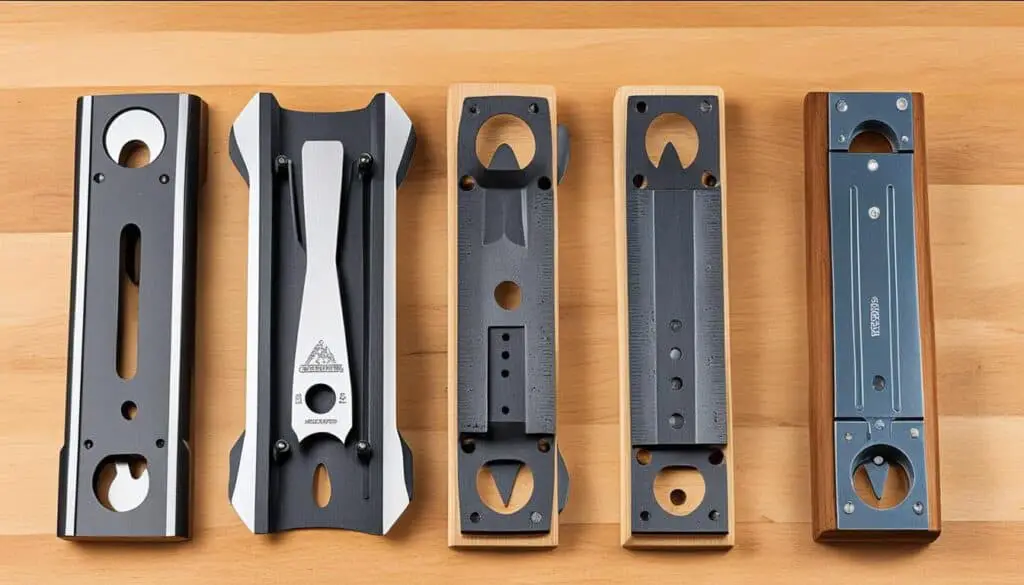
As you can see, there are different types of hand planes available, each with its own advantages. Whether you prefer the traditional charm of wooden planes or the versatility of metal planes, having a well-rounded collection of hand planes will help you tackle woodworking projects with ease and precision.
Optimizing Hand Planes for Different Woodworking Tasks
When it comes to woodworking, hand planes are versatile tools that can be optimized for various tasks, such as wood dimensioning, surfacing, smoothing, edge jointing, and tearout control. By understanding and adjusting key factors, including depth of cut, iron camber, mouth width, and sole flatness, you can achieve superior results in your woodworking projects.
Depth of Cut
The depth of cut refers to the thickness of the shavings removed by the hand plane. For heavy material removal, such as wood dimensioning or surfacing rough stock, a deeper cut is desired. In contrast, for smoothing or fine-tuning surfaces, a shallower cut is more suitable. Adjusting the depth of cut allows you to control the aggressiveness of the hand plane and achieve the desired outcome.
Iron Camber
Iron camber refers to the curvature of the blade edge from side to side. By cambering the iron, you can optimize the hand plane for specific tasks. A heavier camber is suitable for removing material quickly, making it ideal for edge jointing or rough surfacing. On the other hand, a lighter or no camber is preferred for smoothing or achieving a fine finish. Adjusting the iron camber gives you control over the hand plane’s performance and versatility.
Mouth Width
The mouth of the hand plane plays a crucial role in tearout control. Tearout occurs when the grain of the wood lifts and splits, resulting in an uneven or rough surface. By adjusting the mouth width, you can minimize tearout and achieve smoother results. For challenging grain or highly figured wood, a narrower mouth is recommended, while for straight-grained wood, a wider mouth may be suitable.
Sole Flatness and Length
The flatness and length of the hand plane’s sole affect its ability to flatten boards and straighten edges. A flat and long sole ensures even contact with the wood surface, allowing you to achieve precise flattening and straightening. It is essential to regularly check and maintain the flatness of the sole to ensure optimal performance. You can use a flatness-checking tool or a straightedge paired with a light source to identify any imperfections and correct them if necessary.
| Factors to Consider | Optimization Options |
|---|---|
| Depth of Cut | Adjust for heavy material removal or fine smoothing |
| Iron Camber | Customize for aggressive stock removal or fine finish |
| Mouth Width | Control tearout by narrowing or widening the mouth |
| Sole Flatness and Length | Maintain a flat, long sole for precise flattening and straightening |
Optimizing your hand planes for different woodworking tasks is key to achieving exceptional results. By adjusting the depth of cut, iron camber, mouth width, and sole flatness, you can tailor your hand planes to the specific requirements of each project. Whether you’re dimensioning rough stock, surfacing fine surfaces, or jointing edges, optimizing your hand planes will enhance your woodworking experience and produce outstanding craftsmanship.
Vintage Hand Planes for Budget-Conscious Woodworkers
If you’re a woodworker on a budget, vintage hand planes can be a cost-effective option for acquiring high-quality tools. When it comes to vintage hand planes, one brand that stands out is Stanley, especially those manufactured before World War II. These planes are highly regarded for their craftsmanship and durability, and they are often available at antique stores and flea markets.
Although vintage hand planes may require a little restoration work, they can be restored to great working condition with some rust removal and, in some cases, a new blade. One advantage of wooden planes is that their soles can be flattened using shorter bench planes, making the restoration process faster and more efficient.
If you decide to venture into antique stores and flea markets to find vintage hand planes, it’s important to pay attention to the condition of the plane, specifically the sole and the blade. Look for planes with flat soles, as this ensures optimal performance and ease of use. Additionally, check for any cracks or chips in the body of the plane.
| Advantages of Vintage Hand Planes | Considerations for Purchasing Vintage Hand Planes |
|---|---|
|
|
Restoring and using vintage hand planes not only allows you to save money but also gives you the opportunity to own a piece of woodworking history. These hand planes have stood the test of time and continue to deliver exceptional results in the hands of skilled woodworkers.
Quote:
“Vintage hand planes offer a unique charm and can be a great addition to any woodworker’s tool collection. With a little bit of restoration work, these planes can be brought back to life and serve you well on your woodworking journey.” – Woodworking Expert
Hand Plane Techniques for Flattening and Straightening
Flattening and straightening wood are essential tasks in woodworking, and hand planes can be highly effective tools for achieving these goals. When it comes to general board flattening, a jointer plane, such as a No. 5 Jack Plane, is recommended. Its longer length allows for more efficient and accurate surface leveling. By utilizing a jointer plane, you can easily straighten and join edges, resulting in a smoother and more aesthetically pleasing finish.
In addition to jointer planes, smoothing planes are often preferred for smaller-scale smoothing. These planes are designed to create a finer and smoother surface by removing any remaining imperfections. By using a smaller smoothing plane, you can achieve optimal control and precision, ensuring that your wood surfaces are flawlessly flat and straight.
When employing hand plane techniques for flattening and straightening, it is vital to consider the appropriate plane for the specific task at hand. By utilizing the right hand plane and employing proper techniques, you can transform rough and uneven wood into perfectly flat and straight surfaces that are ready for further refinement and finishing.
Hand Plane Techniques for Flattening and Straightening
| Hand Plane Technique | Description |
|---|---|
| Consistent Pressure | Apply even pressure throughout the entire stroke to achieve a uniform surface. |
| Appropriate Blade Depth | Adjust the blade depth to remove material gradually, preventing excessive tearout or chip-out. |
| Proper Hand Placement | Hold the hand plane firmly with both hands, placing pressure on the front knob and keeping the handle parallel to the workpiece. |
| Overlapping Strokes | Overlap each pass slightly to ensure consistent material removal and evenness across the entire surface. |
| Checking for Flatness | Regularly use a straightedge or winding sticks to check for any remaining high or low spots, and adjust your planing technique accordingly. |
By implementing these hand plane techniques and utilizing the right plane for the task, you can achieve exceptional results when flattening and straightening wood. These techniques allow you to create perfectly leveled surfaces, providing a solid foundation for your woodworking projects.
For a visual demonstration of these techniques, refer to the following diagram:
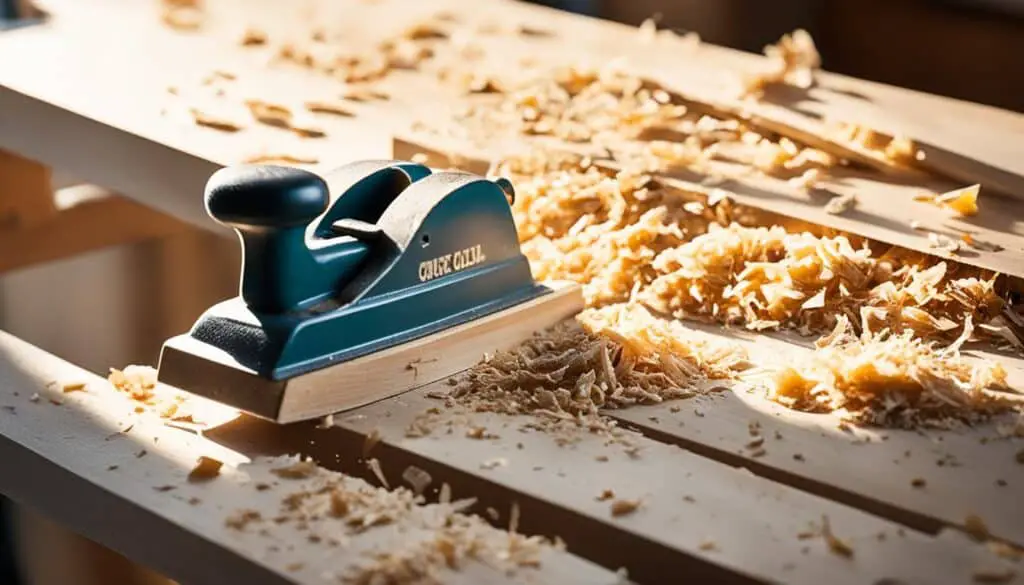
“Using the appropriate hand plane and employing proper techniques, you can transform rough and uneven wood into perfectly flat and straight surfaces.”
Metal vs. Wooden Hand Planes: Pros and Cons
When it comes to choosing hand planes for your woodworking projects, you have two primary options: metal planes and wooden planes. Both types have their advantages and considerations. Let’s explore the pros and cons of each to help you make an informed decision.
Metal Hand Planes
Metal planes are renowned for their versatility, making them a popular choice among woodworkers. These planes can be easily adjusted to handle a wide range of shaving thicknesses, allowing you to tackle various tasks with a single plane. Whether you need to remove material quickly or achieve a fine finish, a metal plane can deliver consistent results.
One notable advantage of metal planes is their ease of use. With simple adjustments, you can modify the blade depth and angle, making on-the-fly changes to suit different woodworking needs. The user-friendly design of metal planes enables efficient and precise adjustments, resulting in smoother and more accurate cuts.
A noteworthy feature of metal planes is their versatility, allowing you to handle varying shaving thicknesses and make adjustments on the fly. They are also known for their ease of use, making them a convenient choice for both novice and experienced woodworkers.
While metal planes offer durability and ease of adjustment, they might lack the unique feel and charm of wooden planes. However, if versatility, adjustability, and ease of use are your top considerations, a metal hand plane might be the ideal choice for you.
Wooden Hand Planes
Wooden hand planes offer a distinct experience and come with their own set of advantages. These planes are often favored by woodworking enthusiasts for their ability to deliver a unique feel and connection to the workpiece. The wooden body can absorb vibrations, adding a level of comfort and control during use.
In terms of restoration projects, wooden hand planes can be more cost-effective compared to their metal counterparts. With a little restoration work, such as removing rust and sharpening the blade, a vintage wooden plane can be revived and put to use. This cost-saving advantage makes wooden planes an attractive option, especially for budget-conscious woodworkers.
Wooden planes provide a unique feel and can be more cost-effective for restoration projects. They offer comfort and control due to their ability to absorb vibrations. While they have a steeper learning curve, wooden planes can be set up for specific tasks like roughing work with a heavy camber.
However, it’s important to note that working with wooden planes may require a steeper learning curve compared to metal planes. Achieving consistent results can take time and practice, and the setup process for different tasks, such as roughing work with a heavy camber, may require some adjustments.
In summary, the choice between metal and wooden hand planes ultimately depends on your individual preferences and specific woodworking needs. Metal planes offer versatility and ease of adjustment, making them suitable for a wide range of tasks. On the other hand, wooden planes provide a unique feel and can be more cost-effective for restoration projects. Consider your woodworking goals and personal preferences to determine which type of hand plane will best serve your needs.
Hand Planing for Beginners: Tips and Guidance
If you’re new to woodworking, hand planing can seem like a daunting skill to learn. However, with the right tips and guidance, you can quickly master this technique and achieve professional results. In this section, we’ll provide you with essential advice on hand plane setup, shaving thickness control, and proper hand positioning.
Understanding Hand Plane Setup
Before you start hand planing, it’s crucial to set up your hand plane correctly. Pay attention to sharpening the blade and adjusting the depth of cut to ensure optimal performance. A sharp blade will minimize tearout, while adjusting the depth of cut will allow you to control the amount of wood you remove with each pass. Take the time to learn and practice these setup techniques to achieve the best results.
Controlling Shaving Thickness
When hand planing, controlling the thickness of the shavings is essential for achieving a smooth surface. Adjusting the depth of cut, as mentioned earlier, will help you regulate the shaving thickness. Start with a shallow cut and gradually increase it until you find the sweet spot that produces thin and consistent shavings. Experiment with different settings to achieve the desired finish.
Proper Hand Position
Your hand position plays a significant role in the effectiveness and safety of hand planing. Place your dominant hand on the rear handle and your other hand on the front knob or tote. Maintain a firm grip and keep your hands slightly behind the blade to ensure stability and control. This hand position will give you the leverage and control needed to guide the plane smoothly along the wood.
Remember, hand planing is a skill that requires practice and patience to master. Start with small projects and gradually work your way up to larger ones. As you gain experience, you’ll develop a feel for the wood and the plane, allowing you to make adjustments and improvements along the way.
Now that you have a solid understanding of hand planing for beginners, let’s move on to exploring online resources that can further enhance your hand plane techniques.
Online Resources for Learning Hand Plane Techniques
When it comes to mastering hand plane techniques, there is a wealth of online resources available to guide you on your woodworking journey. Whether you prefer video tutorials or premium video series, these resources can provide valuable visual guidance and in-depth instructions to enhance your skills.
If you’re looking for free video tutorials, platforms like YouTube offer a wide range of content from experienced woodworkers. These videos showcase hand plane techniques in action, allowing you to learn from their demonstrations and apply those techniques to your own projects.
For a more comprehensive and immersive learning experience, premium video series are worth exploring. These series are specifically designed to enhance your hand plane techniques and often include detailed instructions and step-by-step projects that exclusively use hand tools. By investing in these premium resources, you can gain access to expert guidance and further refine your woodworking skills.
Whether you’re a beginner or an experienced woodworker, these online resources can help you improve your hand plane techniques and achieve professional-level results in your woodworking projects. Take advantage of the visual demonstrations and detailed instructions provided by these resources to elevate your woodworking skills to new heights.
Tools and Supplies for Hand Plane Maintenance
Proper maintenance is essential for keeping hand planes in optimal condition. By regularly maintaining and occasionally adjusting your hand planes, you can ensure that they continue to deliver precise and smooth results. Here are some tools and supplies that are essential for hand plane maintenance:
Sharpening Stones or Systems
Sharpening stones or systems are crucial for maintaining a sharp blade on your hand plane. These tools help you remove any nicks or dullness from the blade, ensuring that it cuts smoothly through the wood. Investing in high-quality sharpening stones or systems will make the sharpening process efficient and effective.
Screwdrivers or Adjustment Tools
Having the right screwdrivers or adjustment tools is important for blade adjustment on your hand plane. These tools allow you to fine-tune the blade’s position and angle, ensuring optimal cutting performance. It’s essential to have a variety of screwdrivers or adjustment tools to accommodate different hand plane models and mechanisms.
Tools for Honing the Blade
In addition to sharpening, honing the blade is necessary for achieving a razor-sharp edge. Honing helps refine the blade’s sharpness and removes any burrs formed during sharpening. Honing guides, honing stones, and strops are popular tools for honing the blade. These tools facilitate consistent and controlled honing, resulting in a polished cutting edge.
Tools for Checking Sole Flatness
Sole flatness is crucial for the optimal performance of a hand plane. Tools like straightedges, feeler gauges, and precision levels are used to check the flatness of the plane’s sole. By ensuring that the sole is perfectly flat, you can achieve even and consistent cuts across the wood surface.
Remember, a well-maintained hand plane is a joy to use and can significantly enhance your woodworking experience. Regularly inspect your hand planes for any damage or wear and promptly address any maintenance needs. With the right tools and supplies, you can keep your hand planes in top-notch condition and enjoy precise and satisfying woodworking results.
| Tools and Supplies | Description |
|---|---|
| Sharpening Stones or Systems | Essential for maintaining a sharp blade by removing nicks and dullness. |
| Screwdrivers or Adjustment Tools | Used for fine-tuning the blade’s position and angle for optimal cutting performance. |
| Tools for Honing the Blade | Facilitate the process of refining the blade’s sharpness and removing burrs. |
| Tools for Checking Sole Flatness | Used to ensure the sole of the hand plane is perfectly flat for even and consistent cuts. |
Conclusion
Hand planes are essential tools for woodworking professionals who strive for a flawless finish in their projects. By implementing the hand plane tips and techniques discussed in this article, you can unlock the full potential of your woodworking skills. Whether you’re using bench planes for stock preparation, incorporating hand planes in furniture making, or optimizing hand planes for different tasks, the careful application of hand plane techniques will result in high-quality woodworking projects.
By understanding the versatility of hand planes in furniture making, you can elevate your projects by efficiently preparing stock, fine-tuning components, and achieving polished surfaces that surpass machine or sandpaper finishes. Hand planes play a critical role in basic stock preparation, allowing you to remove imperfections and leave behind a smooth, flawless surface.
Choosing the right hand planes for your woodworking toolkit is important, especially if you’re working on a budget. Investing in a quality block plane and essential bench planes like the No.5 Jack Plane and the No.4 Smoother Plane can provide versatility and affordability. Additionally, exploring vintage hand planes can be a cost-effective option, as they can be restored to excellent working condition.
Whether you prefer metal or wooden hand planes, each has its own advantages. Metal planes offer versatility and ease of adjustment, while wooden planes provide a unique feel and can be more affordable for restoration projects. By optimizing the hand plane techniques for different woodworking tasks and mastering the art of hand planing, you can achieve perfectly flat and straight wood surfaces, ensuring a flawless finish in your projects.
FAQ
What are hand planes used for in woodworking?
Hand planes are not just cleanup tools; they play a crucial role in stock preparation, fine-tuning components, and trimming glued-up assemblies. They can also remove mill marks, tame panel glue-ups, fine-tune frames, fit doors, and clean up dovetails.
What types of hand planes are used for basic stock preparation?
Bench planes, such as the jack plane and the smoother plane, are essential for basic stock preparation. The jack plane is ideal for removing heavy mill marks, while the smoother plane can clean up any remaining marks and leave a smooth, polished surface.
What hand planes are recommended for beginners on a budget?
For beginners on a budget, a quality block plane is a good starting point. In terms of bench planes, the No.5 Jack Plane and the No.4 Smoother Plane are recommended for their versatility and common usage in woodworking.
What are the different types of hand planes?
Hand planes come in various types, including bench planes, wooden planes, and metal planes. Bench planes are the most fundamental and commonly used hand planes in a woodworking toolkit. Wooden planes have their advantages in terms of restoration and ease of use, while metal planes offer versatility and ease of adjustment.
How can hand planes be optimized for different woodworking tasks?
Hand planes can be optimized for different woodworking tasks by considering factors like depth of cut, iron camber, mouth width, and sole flatness. The depth of cut determines the heaviness of the shavings, while iron camber can be adjusted for heavy stock removal or fine smoothing. Mouth width plays a role in controlling tearout, and sole flatness and length affect the plane’s ability to flatten boards and straighten edges.
Are vintage hand planes a cost-effective option for woodworking?
Yes, vintage hand planes can be a cost-effective option for woodworking. Pre-WWII Stanley planes are highly regarded and often available at antique stores and flea markets. With a little rust removal and possibly a new blade, these vintage tools can be restored to great working condition.
What hand plane is recommended for flattening and straightening wood?
A jointer plane, ideally a longer one like a No. 5 Jack Plane, is recommended for general board flattening. It can make the process of straightening and joining edges easier and more satisfying. For smaller-scale smoothing, a smaller smoothing plane is often preferred.
What are the pros and cons of metal vs. wooden hand planes?
Metal planes offer versatility, as one plane can be set up to handle a wide range of shaving thicknesses and they are easy to adjust. Wooden planes provide a unique feel and can be more cost-effective for restoration projects. However, wooden planes have a steeper learning curve but can be set up for specific tasks like roughing work with a heavy camber.
What are some tips for woodworking beginners learning hand planing?
Some tips for woodworking beginners learning hand planing include understanding hand plane setup, including sharpening the blade and adjusting the depth of cut. Controlling the shaving thickness and positioning your hands correctly are crucial for achieving smooth and even results. Practice and patience are key to developing the necessary skills and techniques for successful hand planing.
Are there online resources available for learning hand plane techniques?
Yes, there are many online resources available for learning hand plane techniques. Video tutorials on platforms like YouTube can provide visual guidance and demonstrations. Additionally, premium video series offer in-depth instructions and projects that exclusively use hand tools.
What tools and supplies are needed for hand plane maintenance?
Tools and supplies for hand plane maintenance include sharpening stones or systems for honing the blade, screwdrivers or adjustment tools for blade adjustment, and tools for checking sole flatness. Regular maintenance and occasional adjustments will ensure that hand planes perform at their best and continue to deliver precise and smooth results.


